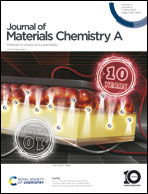Development of rigidity-controlled terpolymer donors for high-performance and mechanically robust organic solar cells†
Abstract
Organic solar cells (OSCs) are potential power sources for wearable electronic devices. However, the mechanical stretchability of active materials is not yet sufficient; one of the main reasons is the high rigidity of polymer donors (PDs) and the resultant excessive crystalline structures, which makes the active layer mechanically-fragile. In this study, we develop a series of PM6-based terpolymers (PM6-BX; X = 10–30, X indicates the mole percentage of the third component) in which a bulky electro-active third component, 7,8-bis(5-hexylthiophen-2-yl)-11H-benzo[4,5] imidazo[2,1-a]isoindol-11-one (BID), is introduced to reduce the tightness of their molecular packing. As a result, the neat PD film with 10 mol% BID (PM6-B10) exhibits significantly improved mechanical ductility (i.e., average crack onset strain (COSavg) of 23.8%) compared to that of the neat PM6 film (COSavg = 14.9%) without a BID unit. In addition, in terms of a blend film, the well-intermixed domains of PM6-B10 and a small molecule acceptor afford OSCs with a high power conversion efficiency (PCE) of 17.2% and mechanical stretchability (COSavg = 11.4%), outperforming the PM6 counterpart (PCE = 15.8%, COSavg = 2.0%). This study suggests important guidelines for the design of efficient PDs for high-performance, stretchable OSCs.

- This article is part of the themed collection: Photofunctional Materials and Transformations


 Please wait while we load your content...
Please wait while we load your content...